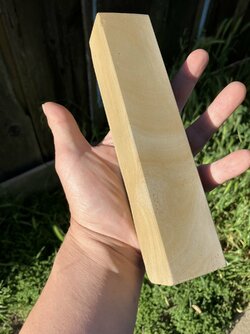Yesterday, I went into a countryside antique store and asked the owner if she had any whetstones. I enjoy looking around for the occasional straight razor or hone. She pulled out from behind the cash register a fully painted 8" X 1 3/4" X 1 1/4" stone saying this was my grandfather's sharpening stone for his razors. It's very good but she hadn't researched it yet.
I was a little bewildered. It had all 6 sides painted, what they heck did she think she was going to research that would tell her what it is and what price to ask.
I knew her from years past and I was perfectly happy to pay her $20 CAD for this unknown stone, but then she wanted $40. I could see that it appears to be a natural stone, the few scratches showed a creamy fine grain and the sides have bands that resemble wood grain. The creamy stone looks like Belgian Blonde Cuticole but the grains on the side made me recall something about Thurigan or Indiana Hindostone being formed in layers and showing these bands.
I have no idea what this stone is. I guess I'm looking for input, best guesses and advice before I start stripping off the paint. My inclination is to put it on a diamond plate and re-flatten its flat surface and give it a try on a razor. I'm also thinking of flattening one side to have a look at those bands or all 6 sides unless there is a reason that I should preserve the paint. I'm also wondering why the heck someone would paint the whole stone.
I'm not worried about the price or value. The entertainment in trying this out and getting back to her with information on her grandfather's stone would be worth the $40.


I was a little bewildered. It had all 6 sides painted, what they heck did she think she was going to research that would tell her what it is and what price to ask.
I knew her from years past and I was perfectly happy to pay her $20 CAD for this unknown stone, but then she wanted $40. I could see that it appears to be a natural stone, the few scratches showed a creamy fine grain and the sides have bands that resemble wood grain. The creamy stone looks like Belgian Blonde Cuticole but the grains on the side made me recall something about Thurigan or Indiana Hindostone being formed in layers and showing these bands.
I have no idea what this stone is. I guess I'm looking for input, best guesses and advice before I start stripping off the paint. My inclination is to put it on a diamond plate and re-flatten its flat surface and give it a try on a razor. I'm also thinking of flattening one side to have a look at those bands or all 6 sides unless there is a reason that I should preserve the paint. I'm also wondering why the heck someone would paint the whole stone.
I'm not worried about the price or value. The entertainment in trying this out and getting back to her with information on her grandfather's stone would be worth the $40.
Last edited:




